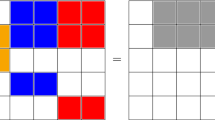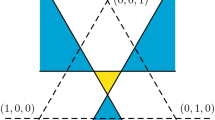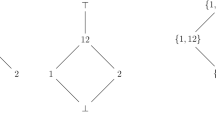Abstract
The core cover of a TU-game is a superset of the core and equals the convex hull of its larginal vectors. A larginal vector corresponds to an ordering of the players and describes the efficient payoff vector giving the first players in the ordering their utopia demand as long as it is still possible to assign the remaining players at least their minimum right. A game is called compromise stable if the core is equal to the core cover, i.e. the core is the convex hull of the larginal vectors. This paper analyzes the structure of orderings corresponding to larginal vectors of the core cover and conditions ensuring equality between core cover and core. We introduce compromise complete (or c-complete) sets that satisfy the condition that if every larginal vector corresponding to an ordering of the set is a core element, then the game is compromise stable. We use combinatorial arguments to give a complete characterization of these sets. More specifically, we find c-complete sets of minimum cardinality and a closed formula for the minimum number of orderings in c-complete sets. Furthermore, we discuss the number of different larginal vectors corresponding to a c-complete set of orderings.

Similar content being viewed by others
References
Curiel IJ, Maschler M, Tijs SH (1988) Bankruptcy games. Z Oper Res 31:143–159
Driessen THS (1985) Properties of 1-convex \(n\)-person games. Oper Res Spektrum 7:19–27
Estévez-Fernández A, Fiestras-Janiero MG, Mosquera MA, Sánchez-Rodríguez E (2012) A bankruptcy approach to the core cover. Math Methods Oper Res 76:343–359
Frankl P (1995) Extremal set systems. In: Graham RL, Grötschel M, Lovász L (eds) Handbook of combinatorics. Elsevier, Amsterdam, pp 1293–1329
Gillies D (1953) Some theorems on n-person games. PhD thesis, Princeton University Press, Princeton, New Jersey
Ichiishi T (1981) Super-modularity: applications to convex games and the greedy algorithm for LP. J Econ Theory 25:283–286
Muto S, Nakayama M, Potters J, Tijs SH (1988) On big boss games. Econ Stud Q 39:303–321
Potters J, Poos R, Muto S, Tijs SH (1989) Clan games. Games Econ Behav 1:275–293
Quant M, Borm P, Reijnierse H, van Velzen B (2005) The core cover in relation to the nucleolus and the Weber set. Int J Game Theory 33:491–503
Rafels C, Ybern N (1995) Even and odd marginal worth vectors, Owen’s multilinear extension and convex games. Int J Game theory 24:113–126
Shapley LS (1971) Cores of convex games. Int J Game Theory 1:11–26
Schmeidler D (1969) The nucleolus of a characteristic function game. SIAM J Appl Math 17:1163–1170
Tijs SH, Lipperts FAS (1982) The hypercube and the core cover of \(n\)-person cooperative games. Cahiers du Centre d’Études de Recherche Opérationelle 24:27–37
Trotter WT (1995) Partially Ordered Sets. In: Graham RL, Grötschel M, Lovász L (eds) Handbook of combinatorics. Elsevier, Amsterdam, pp 435–480
van Velzen B, Hamers H, Norde H (2002) Convexity and marginal vectors. Int J Game Theory 31:323–330
van Velzen B, Hamers H, Norde H (2004) Characterizing convexity of games using marginal vectors. Discret Appl Math 143:298–306
Weber RJ (1988) Probabilistic values of games. In: Roth AE (ed) The Shapley value. Cambridge University Press, Cambridge, pp 101–119
Author information
Authors and Affiliations
Corresponding author
Rights and permissions
About this article
Cite this article
Platz, T.T., Hamers, H. & Quant, M. C-complete sets for compromise stable games. Math Meth Oper Res 80, 213–223 (2014). https://doi.org/10.1007/s00186-014-0477-6
Received:
Accepted:
Published:
Issue Date:
DOI: https://doi.org/10.1007/s00186-014-0477-6




